Stimulation of childbirth is an artificial induction of childbirth, used in various periods of pregnancy, including in case of a child re-wearing, as well as activation of weak labor activity directly during childbirth. This procedure can be used if the duration of labor increases unnecessarily, which is possible if the first stage of labor (opening of the cervix) lengthens, as well as the second stage (expulsion of the fetus).
____________________________
At the same time, not every “delay” in labor is required to be stimulated, so doctors are obliged to analyze the situation, understand the causes and act accordingly.
Medical indications for artificial stimulation of labor are:
- 1. true postponed pregnancy, especially if there are pathological changes in the placenta or signs of abnormalities in the fetus;
- 2. premature detachment of the placenta, due to a direct threat to the life of the child;
- 3. premature discharge of water in a pregnant woman, due to an increased risk of infection penetrating through the cervix;
- 4. sometimes - late toxicosis;
- 5. some diseases of the mother, for example, severe diabetes, etc.
Stimulation of labor in post-term pregnancy
The duration of pregnancy is 40 weeks, after which the baby should be born. However, the onset of 40 weeks is not always preceded by childbirth, there are women who seriously “overwrite” the prescribed periods of pregnancy. Until week 42, only 10% of pregnant women "manage". Do not be particularly worried if you happen to be one of them. In 70% of cases, this is in fact not a postponed pregnancy, but a banal error in stating its timing, the estimated date of delivery is incorrectly calculated. It is not excluded that everything goes strictly according to the schedule established by nature.
However, blindly rely on a possible error is not worth it. In order not to miss a really postponed pregnancy, constant medical supervision is necessary. In this regard, it is reasonable to use ultrasound of a child with Doppler, the study of the pulse. In addition, amnioscopy is recommended - examination of the fetal bladder with a special device amnioscope introduced into the cervical canal. Using this method, it is possible to determine if meconium (the baby's original feces) is in the amniotic fluid, to assess the deficiency of amniotic fluid, the lack or complete absence of cheese-like grease, to exfoliate the lower membranes of the membranes from the uterine walls. These survey methods will allow you to take correct solution on the further development of pregnancy and subsequent delivery naturally or artificial methods of stimulation of labor. Sometimes not the onset of childbirth can be the psychological setting of a pregnant woman: for example, mommy decided to give birth to a baby under New Year or please spouse heir to the day of his birth. Then it can be quite a serious conversation with the future mom - such is the natural stimulation of childbirth, and then everything goes, "like clockwork."
 There are a number of indicators by which a truly perennial pregnancy is judged:
There are a number of indicators by which a truly perennial pregnancy is judged:
- 1. the absence of "front waters" - enveloping the baby's head;
- 2. the volume of amniotic fluid has decreased dramatically;
- 3. the amniotic fluid is muddy, polluted by feces of meconium;
- 4. in the amniotic fluid are not observed flakes of cheese-like lubrication of the fetus;
- 5. The bones of the baby's skull are too hard;
- 6. immature cervix;
- 7. There are signs of aging placenta.
If these symptoms are confirmed, the doctor will suggest artificial stimulation of labor or cesarean section surgery.
By itself, postponed pregnancy threatens with complications during labor: bleeding, weak labor, acute hypoxia of the fetus, with all the ensuing consequences. Monitoring the condition of the baby is necessary due to the danger of aging of the placenta. As a result of this process, the placental blood flow is significantly impaired and the baby receives less nutrients. In addition, the production of amniotic fluid decreases with time. Such conditions for the child and his development are simply undesirable. With the help of an ultrasound scan, the doctor can find out that the placenta is thinned and deformed, in which case hormonal therapy must be prescribed to the pregnant woman. This procedure is necessary to approximate the onset of labor.
The symptom of the onset of the period when it is already necessary to give birth is a decrease in the quantity of amniotic fluid, as a result of which the woman stops gaining weight, or even her body weight decreases. A postponed pregnancy can indicate a decreased or, on the contrary, increased fetal activity, as a result of a lack of oxygen due to improper blood circulation in the uterus.
When confirming the fact that the pregnant woman is changing her baby, they begin to stimulate labor. When the birth is still happening, the postponed children look somewhat painful: they are thin, but hyperactive, their skin is wrinkled, dry and scaly, without a layer of fruit lubricant covering the skin of a newborn that appeared in due time. The nails and hair of the "sat up" kids are long, the eyes are open. The umbilical cord is yellowish or even greenish.
Causes of labor induction
Observing the progress of labor, the doctor pays close attention to the following points and signs of the need for outside intervention in the process:
- 1. The presence of contractions, their duration, frequency and strength. Reliably assess these signs helps palpation of the abdomen (uterus), the results of indications of the instrument tokodinamometr, which allows you to accurately record the duration and frequency of contractions, as well as a special intrauterine catheter, which determines the pressure in the uterus against the background of contractions (in practice it is used very rarely).
- 2. Cervical dilatation - the criterion that most accurately determines the normal course of labor. Cervical dilatation is usually measured in centimeters. The minimum disclosure is considered "zero" - 0 cm, in cases where the neck is closed, the maximum - 10 cm, that is, fully opened. Nevertheless, even this indicator is not absolutely reliable, because the measurement, as a rule, is made "by eye". Even the same doctors may have different disclosures, not to mention the cases when different doctors examine one woman. The fact is that the width of the doctor’s fingers serves as a guideline in determining the degree of cervical dilatation: 1 finger corresponds to about 2 cm, 3 fingers - about 6 cm, and so on. The normal rate of opening in the active phase of labor is 1-1.5 centimeters per hour. When this process is slower, may begin to apply any kind of stimulation of labor. However, the actions of doctors are based not only on the degree of disclosure, but also on the state of the pregnant woman.
- 3. Promotion of the presenting part of the baby (usually the head). Fetal advancement or omission is determined by palpation of the woman's abdomen and / or vaginal examination.
If a woman has a normal size of the pelvis, the position of the fetus is correct (prelying down the head), there are no factors that prevent the birth of the child by natural birth canal, the cause of the protracted form of labor can be:
- 1. woman's fear of pain;
- 2. painkillers;
- 3. sedatives;
- 4. the position of the woman on the back;
- 5. some diseases of pregnant women.
Doctors' actions
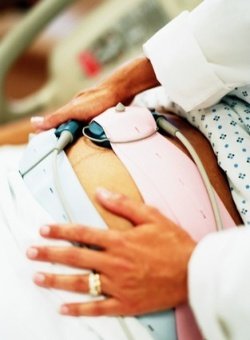 It should be noted that the frequency of use drug stimulation from year to year is growing. The main reasons for this “popularity” are, nevertheless, the state of health of modern pregnant women, as well as the desire of physicians to minimize the possible risks to the fetus. If you consider the use of medications unacceptable, you should discuss with your doctor so that during your childbirth they are used only if absolutely necessary. In addition, different maternity hospitals have their own “favorite” methods of artificial stimulation. Therefore, I recommend to find out in advance exactly what methods of labor induction are preferred by obstetricians of your chosen maternity hospital.
It should be noted that the frequency of use drug stimulation from year to year is growing. The main reasons for this “popularity” are, nevertheless, the state of health of modern pregnant women, as well as the desire of physicians to minimize the possible risks to the fetus. If you consider the use of medications unacceptable, you should discuss with your doctor so that during your childbirth they are used only if absolutely necessary. In addition, different maternity hospitals have their own “favorite” methods of artificial stimulation. Therefore, I recommend to find out in advance exactly what methods of labor induction are preferred by obstetricians of your chosen maternity hospital.
So, what are the ways to stimulate labor? Formally, they can be divided into two main groups:
- 1. stimulating the contractility of the uterus;
- 2. affecting the opening of the cervix.
In addition, the use of sedatives is possible. Often the fear of pain during childbirth can slow down generic activity. In some situations, muting negative emotions can restore the normal natural course of labor.
The need for a caesarean section is explained by the fact that the worn-up children have a rather large head, and while in the womb, they are no longer supplied with sufficient nutrition and oxygen. In addition, there is a risk that the baby will ingest original feces, which is quite dangerous for its health. A caesarean section, however, as well as the stimulation of labor in any case will be applied if:
- 1. A mother in labor suffers from hypertension or diabetes;
- 2. Amniotic fluid as a result of discharge of original feces into it will have a green tint;
- 3. Fetal growth has slowed significantly.
Stimulation of labor, affecting the contractile activity of the uterus
Among obstetricians, the most popular in this group of stimulants are:
- 1. amniotomy;
- 2. synthetic analogues of natural hormones, as a rule, oxytocin.
Amniotomy
So called the process of opening the fetal bladder. An autopsy is performed on a vaginal examination with a sterile plastic instrument that looks like a hook. This procedure is painless, because the fetal bladder does not have pain receptors. It is assumed that amniotomy contributes to the process of mechanical stimulation of the fetal head by the birth canal. In addition, the opening of the fetal bladder indirectly stimulates a more active production of prostaglandins, which enhance labor activity. Data on the effectiveness of amniotomy are contradictory. It is believed that amniotomy and independently, without combining with other methods of stimulation of labor reduces their duration. However, it is not always effective. Therefore, when doctors decide that the woman needs labor, a fetal bladder is still full, they will first carry out an amniotomy, and then, if necessary, take advantage of generic drugs.
Risks of amniotomy
When an amniotomy passes without complications, it absolutely does not affect the condition of the child. This method is generally considered safe because of the rarity of any complications, but they do exist.
Roughly speaking, amniotomy is cutting a well-inflated balloon. Therefore, both with amniotomy and spontaneous rupture of the bladder, umbilical cord prolapse is possible. This complication is threatened by acute oxygen insufficiency of the fetus due to compression of the umbilical cord by the head of the child and the birth canal. In this situation, emergency medical intervention is required.
The surface of the membranes is covered with blood vessels, including rather large ones. Therefore, there is a risk that a blast incision that is carried out blindly can damage such a vessel. As a result, bleeding may begin, sometimes even life-threatening baby.
In order to avoid complications, if possible, they try to do an amniotomy after the baby’s head sinks into the pelvis and squeezes the fetal bladder and its vessels. This helps to prevent bleeding and cord prolapse.
In cases where, with the help of amniotomy, it is still not possible to intensify the generic activity, the risk of infection of the uterus and fetus, which is no longer protected by amniotic fluid and fetal bladder, increases by several times.
Oxytocin
 It is an artificially synthesized analogue of a hormone that is produced by the pituitary gland. Oxytocin is able to stimulate contractions of the uterine muscle fibers. Apply the drug oxytocin:
It is an artificially synthesized analogue of a hormone that is produced by the pituitary gland. Oxytocin is able to stimulate contractions of the uterine muscle fibers. Apply the drug oxytocin:
- 1. in order to artificially cause childbirth;
- 2. with the weakness of labor at any time of birth;
- 3. in cases of postpartum hemorrhage;
- 4. to stimulate lactation.
In order not to provoke severe complications, oxytocin is not used when the fetus is abnormal, and also to stimulate labor in women with a clinically narrow pelvis, when the parameters of the pelvic ring are too small for independent labor.
Oxytocin is used in the form of tablets, but more often it is a solution for intravenous, intramuscular and subcutaneous injections. Intravenous drip of the drug is the most common, however, has a significant drawback: a woman with a connected "dropper" is very limited in movement.
Side Effects of Oxytocin
For the same dose of the drug oxytocin, different women react differently, so standard patterns of use do not exist. The dosage is selected individually, so that there is always the danger of overdose with the possible appearance of side effects.
Oxytocin has no effect on cervical dilatation. In most cases, under the influence of oxytocin, ancestral pain increases, in connection with this, it is usually used in combination with antispasmodics, relaxing the muscles of the uterus.
The drug is not used in cases where the birth of a baby in a natural way, through the birth canal, is undesirable or impossible, with increased sensitivity to the drug, when the position of the fetus is wrong, with placenta previa, as well as in cases of scarring on the uterus, etc.
The most common side effect of oxytocin is an increased contractile activity of the uterus that can lead to impaired blood circulation in it, and, as a result, to a lack of oxygen in the child.
Stimulation of labor, exposure to the cervix
Often the reason for the delayed flow of labor is the resistance, or the immaturity of the uterus - in other words, unavailability for cervical dilatation. The most common method that helps the uterus to "ripen" is based on the use of prostaglandins.
Prostaglandins
These hormones have a pronounced effect on the reproductive function of women. Small amounts of prostaglandins are found in almost all tissues of the human body, but their greatest concentration is in the seminal fluid of a man and the amniotic fluid of a woman. Prostaglandins have a stimulating effect on smooth muscles in general, and on the fallopian tubes, the cervix and the uterus in particular.
The drugs of this group are introduced into the body in different ways. However, doctors try to minimize the systemic effects of these drugs (after tablets, intravenous solutions). This is explained by a wide list of side effects. First, the effects of prostaglandins are similar to those of oxytocin, in terms of actively stimulating the uterus, over-stimulating its contractions of the uterus. As a result of its use are possible: nausea, vomiting, fever, diarrhea, etc. In addition, prostaglandins are more expensive. In this regard, often their use is reduced to the abortion early terms, artificial induction of labor in almost term or fully term pregnancy, and not to stimulate labor in the process of labor.
Currently, local prostaglandins are widely used, in the form of a viscous gel or suppositories inserted into the cervical canal or into the vagina. Its popularity is due to the fact that this method minimizes side effectsand has a significant effect on cervical dilatation. In addition, the local introduction of this stimulator does not interfere with the movements of the woman.
Other means of stimulating labor
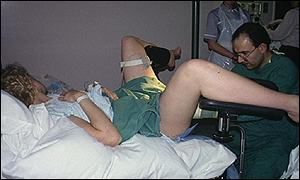 In fact, there are many means and drugs that enhance labor activity, but most of them are extremely rarely used during labor. Often, their use is aimed at combating postpartum hemorrhage due to hypotonia of the uterus - insufficient reduction. Such remedies include herbal preparations, in particular:
In fact, there are many means and drugs that enhance labor activity, but most of them are extremely rarely used during labor. Often, their use is aimed at combating postpartum hemorrhage due to hypotonia of the uterus - insufficient reduction. Such remedies include herbal preparations, in particular:
- 1. ergot,
- 2. common barberry,
- 3. shepherd's grass bag,
- 4. nettle,
- 5. spherophysin, etc.
Many funds lost their positions in recent years, for example, artificially synthesized hormones estrogen - their effectiveness is significantly inferior oxytocin. In addition, there are methods that have not been finalized, but have an impact on the course of labor, the so-called non-traditional methods, for example, acupuncture.
Despite scientific progress, today, unfortunately, there is no way for both obstetricians and patients to the same extent. Therefore, the choice of method of birth stimulation remains for the doctor, who, taking into account the situation, the conditions of the course of pregnancy, the individual characteristics of the woman, will decide.
Woman's actions
 The desire to safely give birth should not be just a dream, not supported by any specific actions. During pregnancy, any moderate physical activity, physical exercise, strengthening the abdominal muscles, the muscles of the perineum, yoga, the ability to relax, breathing exercises - all this has a beneficial effect on the course of labor. In addition, knowledge of the course of the birth process, the correct behavior during childbirth, will reduce the fear and, consequently, help the woman to adequately influence the birth of the baby. The listed knowledge and skills are rather effective natural stimulation of childbirth.
The desire to safely give birth should not be just a dream, not supported by any specific actions. During pregnancy, any moderate physical activity, physical exercise, strengthening the abdominal muscles, the muscles of the perineum, yoga, the ability to relax, breathing exercises - all this has a beneficial effect on the course of labor. In addition, knowledge of the course of the birth process, the correct behavior during childbirth, will reduce the fear and, consequently, help the woman to adequately influence the birth of the baby. The listed knowledge and skills are rather effective natural stimulation of childbirth.
If you have the opportunity to choose the conditions for childbirth and the maternity hospital itself, prefer to choose those where you can walk during the birth (of course, if you have no contraindications to this). The recumbent position, as already proved, increases the duration of labor, as one of the conditions for the rapid and successful opening of the cervix is the pressure on the fetus. Studies conducted in the USA have shown that freedom of movement (walking, sitting in various postures) is no less effective than drug stimulation. Another kind of natural stimulation of childbirth.
Try to get acquainted with the room in which your childbirth will take place. Surprisingly, it also has a beneficial effect on the process of childbirth. The key factor in this is probably the loss of insecurity and fear from unfamiliar surroundings and, in general, from obscurity.
Self-induction of labor at home,
Heads up folk methods stimulation of childbirth nipple stimulation. This massage increases the body's production of oxytocin, a hormone that stimulates generic activity, and largely determines the course and successful outcome of childbirth. By the way, it is this circumstance that explains the fact that the attachment of a newborn immediately after birth to the breast accelerates the birth process. child seats and reduces the risk of postpartum hemorrhage. Unfortunately, this method does not give a 100% guarantee, but does not bring any harm (of course, if you do not overdo it and do not injure your nipples).
In general, in order to bring up the generic activity, there are many methods recommended by obstetricians for independent use. So, the stimulation of labor at home:
- 1. Try using different angles to press with your thumb and forefinger at a point that is higher by 4 fingers of the inner ankle joint. Repeat 3 times, continuing the pressure for 10-15 seconds.
- 2. Contraction and emptying of the intestine triggers the release of prostaglandins, which soften the uterus. For this you can use enema, castor oil and more.
- 3. No less relevant is sex, as well as the technique of nipple stimulation, which has already been repeatedly written earlier. Massage the nipples for 10-15 minutes using various creams, fluids and oils. As a result of the production of oxytocin during the massage process, uterine contractions may occur.
- 4. If childbirth is “late”, go up and down the stairs every day, alternately, then right, then left. This will ensure the active movement of the pelvis in different directions.
- 5. Stimulation of childbirth at home, contains and folk recipes. Perhaps you will be helped by the recipe of the “stimulating generic cocktail”: take 1 cup of orange or apricot juice, mix with 1 cup of soda, or dry champagne, add 2 tbsp. Spoons of castor oil and as many ground almonds. Beat the ingredients in a blender. Cocktail should be drunk all, in small sips, gradually, maximum for an hour. If the time to give birth really has come, the contractions will begin in 2-3 hours, otherwise you will have frustration. A bowel movement, as you remember, is also shown.
 Probably the dominant feeling for you at the moment is fatigue from the “endless” nine months of waiting. However, you still need to look at the situation with optimism. From now on up to the birth, you can afford everything that was previously forbidden because of the stimulating influence on the birth process, namely: long walks, a glass of red wine, sex with the husband. All this is also the popular methods of stimulation of labor, sometimes being very effective.
Probably the dominant feeling for you at the moment is fatigue from the “endless” nine months of waiting. However, you still need to look at the situation with optimism. From now on up to the birth, you can afford everything that was previously forbidden because of the stimulating influence on the birth process, namely: long walks, a glass of red wine, sex with the husband. All this is also the popular methods of stimulation of labor, sometimes being very effective.
If the pregnancy is postponed, you are probably literally ready for anything, so that you finally have contractions. In addition to the above methods, there are abundant popular methods of stimulating childbirth, which have come from the times of the popularity of sorceress and astrologers. I do not presume to judge their effectiveness, and in some cases even the adequacy. Some of them look ridiculous, others are funny. But, as they say, "what the hell is not joking," suddenly they will help you, and if not, then at least a little cheer.
- 1. In order to “lure” the baby into the light and warmth, it is proposed to put a cool heating pad on his stomach, and place a warm one between his legs. In addition, it is necessary to provide a bright light source in the crotch zone. It is understood that the child will strive for light and heat, and the generic process starts.
- 2. According to popular belief, the energy of the trees helps the child to be born more quickly. To do this, you need to hug an oak or birch - trees with strong energy - and communicate with nature. At the same time, it is insisted that this should in no way be chestnut, aspen, willow or poplar - they, allegedly, can have the opposite effect.
- 3. If this does not help either, then perhaps an explanation of the location of the stars! It’s just that the lunar day, in which your baby was conceived, has not yet arrived. If the date of conception is known to you, find out the constellation in which the moon was then in the lunar calendar, to presumably calculate the days of birth. The child must appear to the world on the day when the moon is in the same constellation.
Carried away by all this, do not forget about the recommendations of the doctor. If he assures you that everything is going according to plan, the examination confirmed that the baby feels comfortable, and you have plenty of time to wait - do not rush things. Only 4% of babies are born exactly on the expected date of birth.
And last, remember:no pregnancy can last forever, you are definitely already at the finish and there are days and perhaps hours before the long-awaited meeting with your blood. Good luck to you both and easy childbirth! Let this acquaintance pass by the most that neither is in a pleasant way! Health to your baby and you!
Childbirth is a complex physiological process of expulsion of the fetus from the uterus. After the opening of the cervix in the first period of labor, the child begins to move through the birth canal by uterine contractions - contractions. In the second period, attempts are added to the contractions (contractions of the abdominal muscles and the diaphragm), as a result of which the baby is born into the world. After that, the placenta is quickly separated and the placenta leaves. Here it is, happy ending!
To start a normal labor activity, two basic conditions are necessary: a mature cervix and sufficient strength and duration of contractions. Usually, the cervix "matures" (ie, it becomes soft, shortens to 1 cm or less and opens more than 1 finger) by the 38–39th week of pregnancy. With the onset of labor, the cervix continues to open and flatten. This is due to contractions, as well as pressure on the fetus. An important role is played by the fetal bladder, which “wedges” into the opening of the cervix, contributing to its disclosure. For the successful completion of the first period of labor, the uterine contractions must be sufficiently strong, long, and occur at regular intervals.
In cases where contractions are not intense, short or rare, they speak about the weakness of labor. This condition is also indicated by a low cervical dilatation rate (normally 1 cm per hour). This condition is also diagnosed by observation, CTG (cardiotocography) and vaginal examination.
Distinguish between primary and secondary weakness of labor. Primary is manifested by contractions of weak force, violation of their rhythm and duration from the very beginning of labor. The second variant is characterized by the appearance of the same changes, but not immediately, but after a certain period of time after the development of normal labor.
What is the danger of weak labor?
Many expectant mothers are perplexed - is stimulation of labor really necessary? After all, you can often hear the reasoning about how they gave birth in the old days for several days, and nothing - everyone treated this normally. But it is important to understand that such a situation is not at all the norm and threatens with the development of serious complications. For a child, the danger of weak labor is to increase the risk of developing severe oxygen starvation, which is fraught with neurological disorders and disorders of cerebral circulation in the newborn. In addition, during prolonged labor may enter the lungs of the fetus amniotic fluid, leading to pneumonia and impaired breathing of the child after birth. These consequences often require long-term observation and treatment of the baby in the future.
From the mother’s side, there is a threat of birth injuries, and as a result of an insufficient contraction of the uterus in the postpartum period, bleeding can begin.
Therefore, in all cases of development of the weakness of labor, it is necessary to conduct its stimulation - strengthening the strength, duration and frequency of contractions.
Stimulation in labor: try without drugs
Most often, the concept of “Rodostimulyation” in future mothers is associated with the use of special medications, but, in addition, there are a number of non-drug ways to normalize generic activity:
- The active behavior of women in labor contributes to the enhancement of labor.
- Stimulation of the areola (areola) and breast teat leads to the release of the hormone oxytocin, which increases uterine contractions.
- Generic activity is enhanced by the position of a woman on her side, the same name as the position of the fetus.
- Amniotomy (opening the membranes) is effective measure to activate contractions. This is explained by the fact that after the discharge of amniotic fluid, the volume of the uterus decreases, which allows it to contract more effectively. In addition, amniotomy activates the formation of prostaglandins - substances that are powerful stimulants of uterine contractions. This manipulation is painless, as there are no pain receptors on the surface of the fetal membranes.
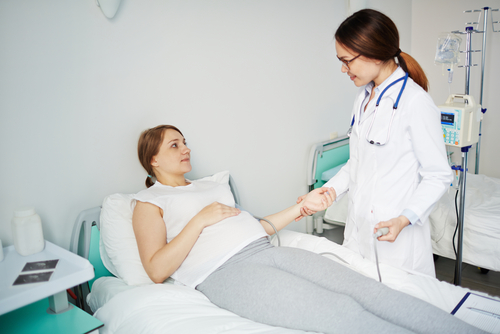
Medical stimulation during labor
Before the start of drug stimulation in labor, it is very important to assess the condition of the woman in labor. With her fatigue, a drug sleep is prescribed, which lasts about 2 hours. The positive effect is due to the fact that during this period labor does not stop, and the cervix continues to unfold. Often, after a rested woman in labor wakes up, labor activity normalizes, and the need for family stimulation may disappear. If this measure does not help, then, as a rule, the doctor decides on drug stimulation during labor.
To date, prostaglandins and oxytocin are used for this purpose.
Prostaglandins are biologically active substances that trigger regular generic activity. They promote cervical dilatation and enhance its contractions. Prostaglandins are used in the development of primary weakness of labor or in the development of secondary weakness of labor forces if the opening of the cervix is not more than 6 cm. These drugs also have side effects - nausea, vomiting, increased blood pressure, increased heart rate, bronchospasm (difficulty respiration due to a decrease in the lumen of the bronchi). Given this, contraindications for the appointment of such funds are bronchial asthma, increased arterial and intraocular pressure (glaucoma), severe liver and kidney disease. These drugs are administered intravenously.
Oxytocin (from the Greek. Oxys - fast, tokos - childbirth) - is a synthetic analogue of the hormone oxytocin, which is responsible for the contractility of the uterus. Since the most frequent reason for the development of weak labor is the lack of production of its own oxytocin, the introduction of this substance helps to correct the situation and normalize the process of childbirth. Sensitivity to oxytocin increases by the end of the first period of labor, so it is most effective for secondary weakness of labor and for weakness of effort. It is also administered intravenously.

The introduction of these drugs requires constant monitoring by an obstetrician-gynecologist and a midwife. Careful monitoring of the contractile activity of the uterus and the condition of the fetus is necessary. It is important to prevent an overdose of prostaglandins and oxytocin, which causes hypertonia of the uterus, which, in turn, leads to impaired uteroplacental circulation and prenatal suffering of the baby, premature detachment of the placenta.
Along with the stimulation of labor, antispasmodic drugs are usually administered to relieve cervical spasm during the contraction and its softening. Strengthening contractions with a dense cervix leads to its ruptures. For the prevention of oxygen starvation of the fetus, drugs are prescribed to improve uteroplacental blood flow and increase the resistance of fetal brain cells to oxygen deficiency.
With persistent weakness of labor, combined with other diseases, and with the impossibility of natural childbirth, a cesarean section is indicated.
The conditions for spinal stimulation are:
- Compliance with the size of the head of the fetus mother's pelvis, which shows the possibility of moving the fetus through the pelvic cavity during labor;
- Satisfactory condition of the baby (according to cardiotocography, ultrasound, doplerometrii uteroplacental blood flow). In case of oxygen starvation of the fetus, it is impossible to perform rod-stimulation, since this can lead to vasospasm, impairment of the uteroplacental circulation and deterioration of the child’s condition.
- Lack of fetal bladder. Rodostimulyation is not carried out at a whole fetal bladder. It threatens with severe complication - placental abruption due to an excessive increase in intrauterine pressure. Usually, when the development of labor is weak, an amniotomy is first performed (puncture of the membranes of the fetal bladder), and then the woman is seen for 2 hours. If during this time labor activity has not returned to normal, medicamental stimulation is prescribed.
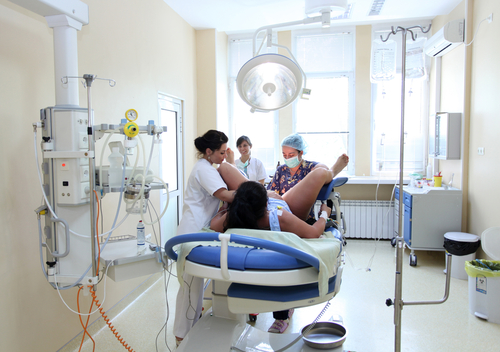
Is it possible to avoid stimulation during labor?
Prevention of the development of the weakness of labor activity in many ways is a normal pregnancy. For the future mother, you need a full sleep - at least 8 hours a day, a balanced and balanced diet, and favorable conditions of psychological comfort. The important role is played by the absence of chronic foci of infection, good physical form, preparation at school for pregnant women and support from relatives. Gymnastics for pregnant women, breathing exercises, swimming in the pool, yoga, walks in the fresh air are recommended. Also future mom You must take vitamins (B6, ascorbic and folic acid), which have properties to increase the energy potential of the uterus.
Such different concepts
It is important to understand that birth stimulation and labor induction are two completely different procedures. Rodostimulation is always an increase in existing contractions, when labor activity began on its own, but then its normal development failed, and it began to weaken. Labor induction is carried out when necessary to cause labor when there are no contractions yet.
Causes of labor weakness:
- previous abortions, miscarriages, curettage of the uterus, inflammatory diseases of the female genital organs, uterine fibroids, hormonal disorders and chronic diseases;
- age of primipara less than 18 and over 35 years;
- a large number of births (4 or more);
- causes leading to uterus overstretching ( large fruit, polyhydramnios, multiple fetuses) that prevent the full reduction of myometrium - uterus muscles;
- genetic predisposition, which can be traced through the female line;
- complications of pregnancy - replantation, placental insufficiency (i.e. the inability of the placenta to meet the needs of developing fetus);
- woman's fear of pain, lack of psychological mood for childbirth.
When the stimulation of labor can not be carried out?
Contraindications for rodstimulyatsii are the presence of a scar on the uterus, the wrong position of the fetus, its oxygen starvation, clinically narrow pelvis (a situation where the size of the head of the fetus does not match the size of the pelvis of the mother), placenta previa (when the placenta blocks the exit from the uterus), severe preeclampsia, fatigue of the woman.
Mothers who have already given birth so often speak about the stimulation of labor, scaring pregnant girlfriends that it seems to them: without speeding up the process of cervical dilatation, it does not do in any birth. In fact, “pushing” childbirth is not so often - according to official statistics, about seven out of a hundred women. How does this happen and why might labor stimulation be needed?
The indications for labor induction are obvious - childbirth does not begin, although it’s long overdue, it’s not progressing when it starts, or for medical reasons it is necessary for the child to be born before the due time. Stimulation can be natural or artificial.
With natural future mom some simple actions accelerates the onset of labor. If this occurs over a period of more than 40 weeks, the doctors will most likely not object. But, of course, you should consult them first. As for artificial stimulation, it is performed only by doctors and only in the maternity hospital.
Oxytocin Administration
Why do you need? Oxytocin is a hormone that is responsible for starting labor and enhances the contractile activity of the uterus. Its synthesized analogue is administered to prepare the uterus for disclosure, if childbirth does not occur in the case of post-term (more than 42 weeks) pregnancy.
How to enter? The hormone is injected intramuscularly or subcutaneously by injection.
Advantages and disadvantages. If childbirth has begun, but then the labor activity suddenly ceased, oxytocin will start the contractions again. But they will be powerful and therefore very painful, so the woman must be injected with painkillers. There is a possibility of an overdose of the drug, and some women may show an increased sensitivity to it.
When can not be used? In the case of placenta previa, abnormal fetal position, narrow pelvis and other obstructions natural childbirth pathologies. You can not use oxytocin after the previous cesarean section, when there is a scar on the uterus.
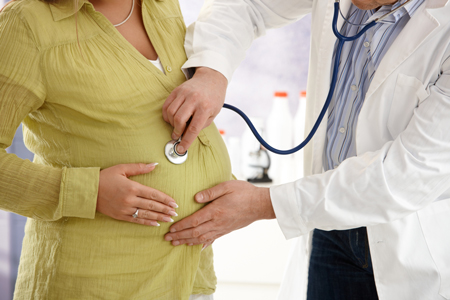
Prostaglandin administration
Why do you need? In order to release the child without injury, the cervix before childbirth must mature - become soft, supple, begin to stretch and unfold. If the term of labor has arrived, and the cervix is not ready yet, its maturation is accelerated by prostaglandins - analogues of the hormones responsible for this process.
How to enter? A gel or suppository containing prostaglandin is inserted deep into the vagina and cervical canal.
Advantages and disadvantages. The advantage is that prostaglandins do not penetrate through the amniotic bubble and do not affect the baby in any way. In addition, a woman, even with the drug injected, is in no way restricted in movement. But at the same time prostaglandins can slow down the transition to the active stage of labor. Some women have an intolerance to the drug, expressed in headache or vomiting.
When can not be used? As with any stimulation of labor, the administration of prostaglandins cannot be used when a woman has endocrine disorders, diabetes mellitus, after cesarean section, and also when giving birth through the birth canal due to an abnormal position, size of the fetus or a deteriorating state of health.
Amniotomy - puncture of the fetal bladder
Why do you need? The puncture of the membranes is made during prolongation of pregnancy, with a deterioration of the placenta and, as a consequence, a high risk of hypoxia in a child. Also, an amniotomy can be carried out when a woman quickly develops preeclampsia - in this state, the outpouring of water speeds up the process and relieves the condition of the woman in labor, simultaneously preventing birth complications that may develop in case of prolonged labor. Sometimes the indication for amniotomy is the risk of developing rhesus conflict.
How do? The operation is completely painless and safe, but, like any other operation, it is performed only by an experienced doctor and only for medical reasons. A special hook is inserted into the vagina, seizing the fetal bladder and opening it, which causes rupture of the amniotic fluid.
Advantages and disadvantages. The rupture of fetal waters triggers the process and intensifies contractions. But sometimes the contractions even after this manipulation may not come, and the dry period should not last more than 12 hours. So women in labor sometimes need the introduction of the same oxytocin to still stimulate childbirth. Moreover, if you do an amniotomy without good evidence, the process can only be slowed down. The front waters, which are above the baby’s head in the fetal bladder, are a wedge that gently opens the cervix from the inside. Normally, water flows only after the neck is almost fully open and the baby is ready to be born.
When can not be used? Amniotomy can be performed only after the baby’s head has passed into the pelvis, squeezing the fetal bladder and the vessels located on its surface. If you make a puncture earlier, there is a high risk of bleeding and cord prolapse, as well as infection.
A long walk, washing the floor without the help of a mop and running around the stairs are the most common methods among future mothers natural stimulation childbirth. The most physiological way is walking.How do? During the long walk, the child puts pressure on the cervix, which makes it begin to unfold. This also contributes to other activities. However, expectant mothers should avoid extreme loads, they should be feasible and light.
Advantages and disadvantages. The method only works if the cervix has already begun to prepare for childbirth - soften and smooth out. Moreover, it is difficult for a woman who wants to “give birth to a woman as soon as possible” to keep from overloading, and washing the floors in a half-bent position and conquering skyscrapers without using an elevator clearly refers to them. All such actions can cause premature placental abruption!
When can not be used? With preeclampsia and other complications of pregnancy, with indications for cesarean section, for up to 40 weeks of pregnancy, for chronic diseases not related to pregnancy.
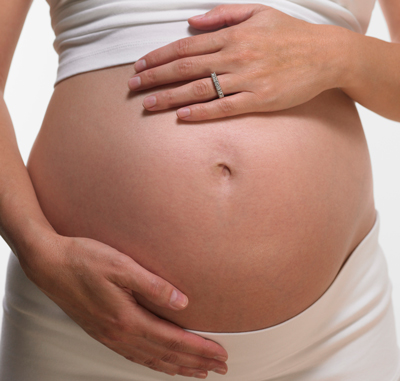
Sexual intercourse
Why do you need? The semen contains natural hormones prostaglandins, which soften the cervix, and the orgasm contributes to its muscle contractions. Massaging the breast (especially the nipples) increases the oxytocin content in the blood.
How do? In the old manner and considering the interesting position of the mother: the woman in demolitions should not be painful, but comfortable and pleasant.
Advantages and disadvantages. And what if the pair really wants nothing? Then the spouses will have to give up sex (and the woman will only have to go for a long walk). As for the nipple massage, it is not so simple either: in order for it to work, it must be done three times a day for 10-20 minutes. Not everyone is able to withstand such a prelude.
When can not be used? The most obvious is if one of the partners has an STD. After all, a condom protected contact, maybe a pleasant one - but an almost meaningless “stimulant”. If the couple was prescribed full sexual peace during pregnancy, you should also consult a doctor.
Sometimes women resort to such natural (but unconventional) methods of labor induction, such as acupuncture, aromatherapy, and homeopathy. It must be remembered that, like any other medical procedure, the stimulation of labor can be beneficial or even harmful, especially when it is done groundlessly and illiterately.
Comment on the article "Stimulation of labor: 5 ways. The introduction of drugs or sex?"
Stimulation of childbirth: 5 ways. Introduction of drugs or sex? With a natural future mom, some simple actions speed up the onset of labor.
Discussion
what do you mean by stimulation - oxytocin? he gives uninterrupted contractions that are not only difficult for the mother, but also for the child, because he experiences constant and excessive compression for which he may not be ready. natural contractions are always softer and intermittent.
opening the bubble? not always the neck opens after it, often all ends EX. or opens, but the tissues are not sufficiently elastic, hence the breaks and / or episodes. By the way, in cases of preterm birth almost always make an episode, although the babies are tiny, but the tissues are not yet ready.
it is better to prepare for childbirth and give birth when the time comes. You can always monitor the condition of the baby, the umbilical cord and the placenta on additional ultrasounds.
i gave birth to almost 41 weeks, a large baby 4250g, without gaps and cuts. I was preparing for childbirth, breathed correctly, straightened up correctly, helped my baby, and he helped me. and I wish you easy natural childbirth :)
Now half of the children, if not more with hypoxia, without any re-paced and stimulating. Plus, not every woman agrees to stimulate and for this you need to lie down in advance at the hospital and there is not always a place. All individually
Stimulation of childbirth without testimony ... Almost a horror story, but knowing better than not knowing !!! And the risk of any complications, it exists in natural childbirth ...
Discussion
So, Arisha and I were very lucky ... We were pierced, and she had hypoxia, and her head was tremendous ...
it is possible therefore in most RDov now wait until the victorious and not stimulate. I was surprised at all when I started reading this konfu, that so many people are stimulated. I remember last time, the doctor very clearly told me that now they are trying not to interfere, the current when there are no options ...
Stimtslyatsiya bad because it completely changes the course of natural childbirth, can cause depression in the child's condition (the same oxytocin) ... Essno there are situations when stimulation ...
Discussion
Why no water?
Vodichka all the time new is being developed.
My first and second births began with the discharge of water.
A few hours later in the hospital at the ultrasound it was clear that there was still a lot of water left :) And the doctors said that EVERYTHING will not spill out.
About stimulation ...
In the first birth after the stimulation, the clan activity stopped. I remember as a nightmare: (and she was exhausted and the child had a bruise on the floor of the head :(
But I can not say that the doctor was wrong. Who knows how it would all end without stimulation?
At the second time, when opening it was almost complete, and every minute I was also stimulated to decide, and under the guise of saline: (At first, in one fight the child advanced so much that I thought I would die: (I tried to escape from the table :) Then the contractions stopped. I gave birth, and then waited 40 minutes. And no stimulation helped until the child was attached to the breast.
I still would not interfere without a special need in the natural process ...
Doctors have instructions - the bout should go so much, the potent period — so much. And it does not depend on how much weight a child is born with - 2.5. kg or 4.5., do not envy and from the body of the mother, one bone is longer adjusted to the size of the baby, the other faster. And this is all individually. One child can give birth in 3 hours and the other in two days. Doctors are uncomfortable. Therefore, they lie down in advance and prepare for a certain day. Only you came and went for them, and all the problems remain with you. Apparently the child for some reason needs exactly that time to be born, and no more and no less. I was told by the midwife that one woman had a good period of 6 hours and the disclosure went for almost two days, and the child was born large and completely healthy, well, he needed just that time. Of course in the hospital would be immediately cut, no one would have stood so long and waited. And yet, the water can not flow out at all, they constantly come in and the child does not suffer when the waters are gone.
methods of natural stimulation of labor: 1.\u003e. methods of natural stimulation of childbirth: 1. walking high legs (90 degrees) 2. walking the stairs without an elevator 3. wash the floor ...
Discussion
Me with the firstborn just entot most sex and helped :) and then really desperate to wait. Neither the staircase nor the cleaning of the floor gave no results :)
Copied from regin Irinad (which gave birth in 5 minutes):
"Immediately I warn you that I saw him only with the permission of the midwife and the gynecologist who was watching me. Although I heard that it would not be worse from him, I still do not recommend drinking it solely on my own initiative.
1 cup of high-quality apricot juice, 1 cup of degassed dry (optional) champagne (in the sense of - stir with a spoon, so that the bubbles come out), 2 tbsp. spoons of castor oil, 2 tbsp. spoonful of chopped almond nuts - mix and drink this whole volume in small portions within 2-3 hours. "
Girls, and what is so bad stimulation? Only the fact that it is not natural? The same prostaglandins are contained in semen, therefore the stimulation of labor with the help of a husband is often ...
Discussion
we were born 2 weeks ago with stimulation - in principle, nothing terrible, but everything is very fast (despite the fact that the neck was ready and the disclosure was already), and therefore the contractions are very painful. I did not have a break between contractions, which is not very pleasant. And the disclosure so quickly went that there was no time to set the epidural. And the attempts, I think, were no different from ordinary ones - it was almost not even painful. In general, if it is necessary to stimulate again the next time - I agree; if only the child was good, and the pain can be endured.
Methods of natural stimulation of labor activity are used in cases of prolongation and to prepare for the birth of the cervix. By the approximate date of the onset of labor, the cervix is significantly shortened, which causes the pregnant woman to have pain in the lumbar region and frequent urination. Natural stimulation helps alleviate the pain and speed up the process if the date of delivery prescribed by a doctor has not occurred. All natural methods of generic stimulation are absolutely safe, both for the child and for his mother.
Nipple stimulation
One of the main ways of natural stimulation of labor is nipple massage. It is believed that when massaging and pinching the nipples in the body of a pregnant woman, the hormone oxytocin begins to be more actively produced, which causes labor pains. Nipples should be stimulated several times a day for 10-15 minutes. When using this method, the contractions should begin within three days after the start of stimulation.
Castor oil
Castor oil, above all, is known as a natural laxative, it is this property that is the main one in stimulating generic activity. Influencing the intestines, the oil simultaneously stimulates the uterus, accelerating generic processes. To mitigate the specific taste of the oil, you can add fruit juice or syrup to it. In half the cases of using this method, 100-150 grams of drunk castor oil cause natural contractions immediately after its use.
Modern traditional medicine does not recommend the use of castor oil, which can cause diarrhea and lead to dehydration.
Walking
Walking with a quick walk, preferably in the fresh air, also contributes to the natural stimulation of labor. When the expectant mother makes active walks, the head of the child under the influence of gravity begins to push harder on the cervix, which stimulates a more active production of oxytocin. As a rule, almost all pregnant women make regular walks before childbirth, therefore, the effectiveness of this method is rather difficult to determine. But to refuse active walks should not be any expectant mother, because they contribute to the adoption of the "correct" position of the fetus before childbirth.
Oxytocin is a hormone of the hypothalamus oligopeptide structure that has a stimulating effect on the smooth muscles of the uterus.
Homeopathy
This method can also be attributed to the natural methods of stimulating generic activity, but when using this method, you should still consult a homeopathist. The main homeopathic remedies that enhance the activity of labor are caulofilum and pulsatilla, which are considered absolutely safe for health. The results of surveys of many women who have already given birth say that homeopathic medicines helped them solve various problems that arise during pregnancy.
In addition to the natural methods of stimulation include: having sex with a mandatory violent orgasm in a pregnant woman, taking a small dose of alcohol, using tinctures of some medicinal herbs, ballooning, acupuncture.
Childbirth is a natural process of the birth of a child into the world, carefully thought out and planned by nature. However, there are cases when it is impossible to do without medical care and stimulation of labor activity is required.
In what cases the labor is stimulated
This procedure is performed to artificially induce childbirth and enhance labor activity directly during labor. First of all, the indication for stimulation is prolonged pregnancy, which entails certain risks, weakness and discoordination of labor activity. In addition, stimulation is prescribed at high water, multiple pregnancy and serious chronic diseases that threaten the health of the mother and child. Depending on indications and a condition of patrimonial activity, various types of stimulation are used.Peeling of amniotic membranes
This method of stimulation is usually used when prolonging pregnancy. This procedure is performed during a routine gynecological examination. It consists in the detachment of the amniotic membrane in the uterine cavity, which contributes to the development of contractions. In this case, the woman does not experience pain sensations due to the absence in the membranes of nerve endings.Prostaglandin use
These physiologically active substances affect the cervix, promoting its maturation and disclosure. Prostaglandin preparations are used vaginally in the form of a gel and suppositories. As a rule, contractions begin within half an hour after their introduction. But there are situations when the generic activity is not activated. In this case, after a day the drug is re-injected.Bubble piercing
This method of stimulation of labor activity is used in protracted contractions, when the head of the child is lowered into the pelvic area. The procedure involves inserting a special hook-shaped instrument through the cervix, which causes puncture of the membranes and rupture of the amniotic fluid. The use of this manipulation is associated with the risk of infection and prolapse of the umbilical cord, which contributes to the disruption of oxygen delivery to the fetus.Use of oxytocin
This drug is an analogue of the natural hormone that stimulates the contraction of the uterus. It is used usually in cases where there is a decline in labor activity - a decrease in the intensity of contractions. The drug is administered intravenously with parallel monitoring of the condition of the fetus and the intensity of contractions.Pills for stimulation of labor
In terms of effectiveness, ease of use, and number of side effects, this method of stimulating labor is the most preferred. It consists in the use of preparations of artificially synthesized anti-progestogens (Mifepristone, Miropriston), which promote the maturation of the cervix and the development of contractions.If childbirth does not begin, and the child should already be born, physicians are forced to resort to their artificial stimulation using various methods. However, each of these methods has its own indications and contraindications, therefore, it is strongly not recommended to ask a doctor to accelerate labor for some reason.

Types of stimulation
Prone pregnancy is characterized by shallow water, a decrease in the thickness of the placenta, a thickening of the cranial bones of the child, and so on. The lack of labor in due time is fraught with a deterioration in the functioning of the placenta, which leads to a significant deterioration of the fetus. In such cases, induction of labor is prescribed, for which an artificial rupture of the membranes of the fetus or amniotomy is often used, during which the bubble is pierced with a hook-like instrument. This procedure is practically painless (there are no nerve endings in the fetal bladder) and allows you to start the delivery process due to the discharge of amniotic fluid.
After an amniotomy is completed, labor activity begins in approximately a few hours.
Also, childbirth is accelerated with the help of a special “prostaglandin” gel, which the obstetrician inserts into the cervix of a woman lying on a gynecological chair. This procedure allows you to start giving birth nine to ten hours after drug administration. If childbirth has begun, but labor is too weak, and the cervix is poorly revealed, doctors resort to stimulation with droppers with oxytocin or prostaglandins. Oxytocin is a hormone produced by the brain that stimulates smooth muscle and increases contractility of the uterus. Prostaglandins (hormone-like substances) have similar properties. Four to six hours after the labor has been stimulated, doctors use one of the above methods to evaluate the benefits of them - if there is no effect, a woman is given a cesarean section.
Features of stimulation
Contraindications to the acceleration of labor are its hyperactivity, hypertension, the presence of chronic hypoxia of the fetus or scar on the uterus, as well as cardiovascular or other dangerous diseases of the woman. Ideally, a woman should give birth on her own, since childbirth is a natural process, which should be accompanied by proper breathing during attempts and fights. Doctors say that women who need to control the birth of a child most often need stimulation, whereas full and instinctive return to the process allows the body to do everything right.
Expectant mothers are recommended to undergo special training in the school for pregnant women - then it is hardly necessary to accelerate labor.
Also, natural childbirth is desirable for the reason that a child born without stimulation suffers less stress during the passage of the birth canal. In addition, non-interference in labor activity prevents the lack of oxygen in the child. The use of drugs for stimulation is also not useful - for example, oxytocin most often gives the skin of newborns a yellowish tint to the skin, since this hormone increases the level of bilirubin in the blood and enters into a chemical reaction with it. Jaundice disappears on its own within a few weeks.
Stimulation is an artificial induction of labor at various stages of pregnancy and the activation of labor activity during childbirth. This procedure may be required if the duration of labor increases, which occurs in case of lengthening of either the first stage of labor (cervical dilatation) or the second (expulsion of the fetus). Since not every “delay” in labor requires stimulation, physicians should, having analyzed the situation, understand its causes and act accordingly.
Observing childbirth, the doctor draws attention to the following points:
The presence of contractions, their frequency, duration and strength. Objectively, these signs are confirmed by palpation of the abdomen (uterus), according to the testimony of the instrument dynamometer, which allows accurate recording of the frequency and duration of contractions, as well as using a special intra-uterine catheter to determine pressure in the uterus against the background of contractions (the latter method is used very rarely).
Cervical dilatation is the most accurate criterion for the normal course of labor. Typically, the disclosure is measured in centimeters. The minimum disclosure - 0 cm, when the cervix is closed, the maximum - 10 cm, with full disclosure. However, this indicator is not completely reliable, because even from the same doctor, the obtained disclosure values can differ, not to mention different doctors examining the same woman (the width of the doctor’s fingers is a guide in determining the degree of opening in centimeters; 2 cm, 3 fingers - 6 cm, etc.). It is believed that the normal rate of cervical dilatation in the active phase of labor -1 -1.5 cm / h. If disclosure is slower, the woman may need some stimulating effects. However, the actions of doctors are determined not only by the degree of disclosure, but also by the state of the woman.
Promotion of the presenting part of the fetus (usually the head). It is determined by palpation of the abdomen and / or vaginal examination. With a normal pelvic size, correct position the fetus and the absence of factors that prevent the birth of the child through the birth canal, prolonged form of childbirth contribute to:
- sedatives;
- painkillers;
- position of the woman on the back;
- woman's fear of pain;
- some diseases of pregnant women.
In addition, there are indications for the artificial induction of labor:
- postponed pregnancy, especially if there are signs of abnormalities in the fetus or pathological changes in the placenta,
- in some situations, late toxicosis,
- premature detachment of the placenta (direct threat to the life of the fetus),
- premature discharge of amniotic fluid (as the likelihood of infection penetrating through the cervix increases),
- some diseases (for example, severe diabetes mellitus), etc.
The desire to give birth safely should not remain a dream, not supported by concrete actions. Moderate physical activity during pregnancy, physical exercise, training the muscles of the abdominals, perineum, breathing exercises, the ability to relax - all this will somehow have a beneficial effect on the course of labor. Knowledge of the course of childbirth, the correct behavior in them will reduce the fear of childbirth, therefore, you will be more able to influence the process of birth of your child. The listed useful knowledge and skills are fairly effective methods of stimulating childbirth.
If you have a choice of conditions for childbirth and a choice of maternity hospital, one of the selection criteria should be the opportunity to go during childbirth (of course, if you do not have contraindications to this). It is proved that the lying position increases the duration of labor, because one of the factors of cervical dilatation - the pressure of the fetus on the cervix is not implemented. If you have the opportunity to get acquainted with the room where the birth will take place - use it. Surprisingly, the factor of prior acquaintance with the maternity ward also has a beneficial effect on the birth process.
During childbirth, you can use the old, but scientifically sound way - nipple stimulation. At the same time in the body increases the production of oxytocin - a hormone that stimulates the generic activity, which largely determines the course of childbirth and their successful outcome. It is this circumstance that can explain the fact that putting a baby on the chest immediately after his birth speeds up the birth of a baby and reduces the likelihood of postpartum bleeding. If, according to doctors, your pregnancy gradually becomes post-term, and there are no signs of an approaching birth, you can also resort to this method. Efficiency is not 100% proven, the main thing is not to overdo it.
Elevated exercise stress may also trigger the onset of labor. But we would advise not to resort to this method of stimulation, because it can be dangerous for both mother and child
Doctors' actions
It should be said that the frequency of use of drug stimulation is increasing from year to year. There are several reasons for this. The main ones are the state of health of women and the desire of doctors to minimize the risk to the fetus. If you would like during your birth medications used only when absolutely necessary, discuss it with your doctor. In addition, different maternity hospitals have their own "favorite" methods of stimulation. It may be useful for you to know what method of stimulation is preferred by obstetricians of the maternity hospital chosen by you.
Ways of stimulation
Amniotomy - the opening of the fetal bladder. It is carried out during a vaginal examination with a sterile plastic instrument resembling a hook. This procedure is painless, because the fetal bladder is deprived of pain receptors. The mechanism of action of amniotomy is not fully understood. It is assumed that the opening of the fetal bladder, firstly, contributes to the mechanical stimulation of the birth canal by the head of the fetus, and secondly, indirectly stimulates the production of prostaglandins, which increase labor activity. Information about the effectiveness of amniotomy is controversial. In general, the prevailing opinion is that amniotomy reduces the duration of labor without the combination with other methods of stimulation. But this method is not always effective. And if the doctors come to the conclusion that this woman in labor requires stimulation, and the fetal bladder is still intact, an amniotomy will be carried out first, and after it, if necessary, resort to the help of generic stimulants.
If the amniotomy is uneventful, it does not affect the child’s condition. Amniotomy is considered a safe method, any complications are quite rare. Nevertheless they exist.
Amniotomy can be thought of as cutting a well-inflated balloon. It becomes clear why in some cases, both amniotomy and spontaneous rupture of the bubble, the umbilical cord falls out. This complication threatens the development of acute oxygen insufficiency of the fetus due to compression of the umbilical cord between the head of the fetus and the birth canal. This situation requires urgent intervention by doctors.
On the surface of the membranes pass blood vessels, including quite large ones. Therefore, if a blister incision is performed blindly, it will damage such a vessel, possibly bleeding, in some cases life-threatening to the child.
In order to avoid complications, an amniotomy is, if possible, tried to be carried out after the head of the fetus enters the pelvis, squeezing the fetal bladder and the vessels passing along its surface. It prevents bleeding and cord prolapse.
If, in spite of amniotomy, the labor is not activated, the likelihood of infection of the uterus and fetus, which is no longer protected by the fetal bladder and amniotic fluid, increases.
Oxytocin is a synthesized analogue of a hormone produced by the pituitary gland. The effect of oxytocin is based on its ability to stimulate contractions of uterine muscle fibers. It is used for artificial induction of labor, with weak labor activity throughout the entire delivery, with postpartum hemorrhage, to stimulate lactation. In order to avoid severe complications, oxytocin is not used for abnormalities in the position of the fetus and clinically narrow pelvis, when the pelvic ring sizes are insufficient for independent deliveries.
Oxytocin is used in the form of tablets, but more often in the form of a solution for intramuscular and subcutaneous injections, and especially intravenous administration. The last use of the drug is most common. True, he has a significant drawback: a woman with a connected drip system ("drip") is very limited in movement.
Different women react differently to the same dose of oxytocin, so standard patterns of using this drug do not exist. Doses are selected individually, therefore, when using oxytocin, there is always the danger of overdose with the appearance of side effects.
Oxytocin does not affect the readiness of the cervix for disclosure. In addition, in most women, after oxytocin begins to act, labor pain increases, therefore, as a rule, it is used in combination with antispasmodics (drugs that relax the muscles of the uterus).
Oxytocin is not used in case of undesirability or impossibility of having a baby through the birth canal, incorrect position of the fetus, hypersensitivity to the drug, placenta previa, the presence of scars on the uterus, etc.
The most common side effect of oxytocin is the excessive contractile activity of the uterus, which can lead to impaired blood circulation in this organ, and, consequently, to a lack of oxygen in the fetus.
Methods affecting the cervix
In some women, the cause of delayed labor is the unreadiness of the cervix to open - in the language of doctors, its resistance, or immaturity. The most common method that helps the uterus to mature is the use of prostaglandins.
Prostaglandins are hormones that have a pronounced effect on reproductive function. In small quantities, they are contained in almost all tissues of the body, but most of them in seminal fluid and amniotic fluid. Prostaglandins are able to stimulate smooth muscles, including the fallopian tubes, the uterus and its neck. Drugs in this group, like oxytocin, are administered differently. However, the route of administration leading to systemic effects of these drugs (in the form of tablets, solutions for intravenous administration) is not very common. This is because, by stimulating the uterus with about the same effect as oxytocin, they lead to more side effects (nausea, vomiting, diarrhea, fever, excessive stimulation of uterine contractions, etc.) and, moreover, cost more. Therefore, Prostaglandins are more often used not for stimulation in the process of childbirth, but for artificial termination of pregnancy in the early stages, artificial induction of childbirth during an almost full-term or full-term pregnancy.
Currently, the method of introducing a viscous gel or suppositories containing Prostaglandins into the vagina or cervix canal is widely used. With this method of administration, the side effects are minimal, and the effect on cervical dilatation is significant. It is also important that the local introduction of this stimulator of labor does not limit the movement of the woman.
Of course, there are quite a few means that enhance labor activity. Many of them are very rarely used during childbirth, but used as a means of combating postpartum hemorrhage, which occurs due to insufficient contraction of the uterus (its hypotension). Among them are herbal preparations (ergot, barberry, nettle, shepherd's purse grass, spherofizin, etc.). Some funds in recent years have lost their positions. This applies, for example, to artificially synthesized hormones estrogen, the effectiveness of which is inferior to oxytocin. There are methods that affect the course of labor, but require additional research, such as acupuncture.
Unfortunately, a method that would suit obstetricians and their patients in all its parameters does not yet exist, just as there are no two similar women in labor. Therefore, the choice of method of stimulation remains for the doctor who makes the decision, taking into account the conditions of the course of pregnancy, childbirth and the individual characteristics of the woman.